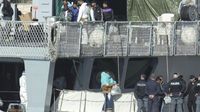Italy’s far-right-led government has taken a significant step in its immigration policy by approving a decree to expand the use of Albanian migration centers. The new regulation, passed on March 28, 2025, allows these centers to serve not only as fast-track asylum processing facilities but also as repatriation hubs for migrants whose asylum requests have been rejected.
The two centers in Albania were initially established to process non-vulnerable migrants rescued in international waters. However, under the new decree, they will now also accommodate migrants who have arrived in Italy, had their asylum requests turned down, and received deportation orders.
Interior Minister Matteo Piantedosi addressed the media on Friday, clarifying that the decree does not alter the core agreement with Albania but adds new functionalities to the existing centers. "The decree changes the law that ratifies the protocol with Albania, but doesn’t change its content, making it possible to transfer to the already existing (repatriation) center of Gjader also migrants coming from Italy," Piantedosi explained. "That would allow us to immediately reactivate that center so that it won’t lose its functions," he added.
The Albanian centers have faced considerable challenges since their opening in October 2024. They have remained largely inactive due to legal hurdles and widespread opposition from human rights organizations, which argue that the centers violate international laws and endanger migrants' rights. The project, which has cost nearly 800 million euros over a five-year investment, has been a disappointment for the conservative government led by Premier Giorgia Meloni.
In fact, the first three groups of migrants transferred to the Albanian centers in October, November, and January were sent back to Italy only hours later after Italian magistrates refused to validate their detention in the non-EU country. This has raised questions about the effectiveness of the centers and the government's broader immigration strategy.
The Italian government's decision to utilize these centers follows a European Commission proposal unveiled in March 2025, which suggested the establishment of new “return hubs” in third countries for rejected asylum-seekers. According to the European Commission, only 20% of individuals with deportation orders are effectively removed from EU territory. The proposal aims to create a standardized approach for all 27 EU member states, allowing national authorities from one country to enforce deportation orders issued by another.
While the Italian government is optimistic about the new decree, it is also awaiting a ruling from the European Court of Justice, expected this summer, which could further enable the Albanian centers to operate as originally intended. This ruling could be pivotal in determining the future of Italy's immigration policy.
In a separate decree, the Italian government has also tightened laws regarding citizenship. Under the new rules, Italian descendants born abroad will automatically become citizens for only two generations. Only those with at least one parent or grandparent born in Italy will be eligible for citizenship from birth. Minister of Foreign Affairs Antonio Tajani indicated that while many descendants of Italian emigrants would still be able to obtain citizenship, limits would be imposed to prevent abuse and the “commercialization” of Italian passports.
This change comes in the context of a significant increase in the number of citizens residing abroad, which has risen from approximately 4.6 million in 2014 to 6.4 million in 2024—a jump of 40%. Italy currently has over 60,000 pending citizenship applications, highlighting the demand for Italian citizenship among those with ancestral ties to the country.
The combination of stricter immigration policies and tightened citizenship rules reflects the Italian government's broader strategy to manage migration and uphold national sovereignty. Critics, however, fear that these measures may lead to increased human rights violations and further complicate the already challenging landscape of European migration.
As Italy navigates these complex issues, the government's approach will likely continue to spark debate both domestically and across the EU. The effectiveness of the Albanian centers, the impact of new citizenship laws, and the outcomes of ongoing legal challenges will all play critical roles in shaping the future of Italy's immigration policy.





